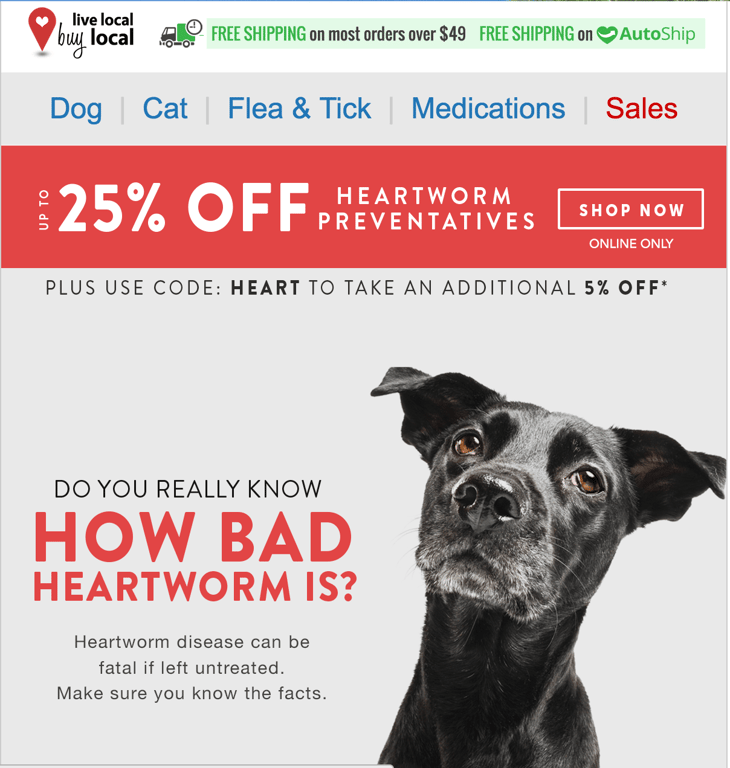 Look familiar? This screenshot comes from an email I recently received from the practice where I take my pets. As nice as the picture looks and as accurate as the messaging is, there are three MAJOR problems with campaigns like this. Let’s take them one by one to make sure you’re not committing one of these loyalty-killers.
Look familiar? This screenshot comes from an email I recently received from the practice where I take my pets. As nice as the picture looks and as accurate as the messaging is, there are three MAJOR problems with campaigns like this. Let’s take them one by one to make sure you’re not committing one of these loyalty-killers.
They’re just not that into email
First of all, email as a marketing channel is weak and getting weaker. Typical open rates for Business-to-Consumer (B-to-C) emails are in the high teens and dropping. Why? Over the last 20 years unimaginative marketers have spammed people to death, with the all-too-predictable consequences of declining compliance and increasing time between office visits. We tell ourselves that the information that we’re sending out is in the patient’s best interest and, while that is undoubtedly true, the message is too often lost in the medium. How many of you have inboxes with hundreds of unread emails? On the other end of each of those emails is a hapless email marketer desperately trying to get you to pay attention to their messaging amid the congestion of the modern email inbox. That's a tough row to hoe.
Broken Record
The other problem with the above ad is that it’s yet another “article” this practice sends me about a product that they happen to sell. For too long we’ve relied on what Seth Godin calls “push” or “interruption” marketing, where a client only hears from you when you are trying to sell them something. People have a hair trigger for these kind of emails in 2016 and are increasingly asking, “Why is it that I only hear from you when you want something from me?”
Go back and look at the last 10 pieces of content that either you or someone on your behalf (as was the case in the above picture) sent to your clients. How many of them were related to something you sell, like heartworm preventative, dentals, or screening labwork? On the other hand, how many of them were purely informational, with no agenda, intended solely to educate your clients? If any more than 2 out of those 10 pieces fit into the first category, you’re making a big mistake. To dig a little deeper, while coupons like the one depicted above may work for 5% of your clients and they lead to a very real revenue boost, what about the OTHER 95% of your clients? What damage are you doing to your relationship with them? You can’t keep going back to the well on the same “compliance” topics or your clients will turn you off, both because you sound like a broken record AND because these topics aren’t all that interesting to them.
So what SHOULD you be writing about? To start, forget that you work in a veterinary practice and put yourself in the shoes of one of your clients. If you really want to do it right, write a “user persona” that describes this client. What do they do? How old are they? Where do they live? How do they consume content? What do they want to learn about? Start very specifically…..”pet owner” is not narrow enough and if you try and be everything to everybody you’ll never break through the immense clutter out there.
Sending too much stuff
Finally, it’s not only the kind of content you have to monitor but also the the volume of content your clients are receiving from you. The above email was the 3rd one I received from this practice in the last week…..WAY too much. Between reminder services, appointment confirmation vendors like DemandForce, review/survey providers, and online pharmacies, many practices are exposing their clients to a lot of “noise" that is counterproductive in the long run.
When it comes to client communications, more is rarely better. It is far better to send out infrequent pieces of high quality, valuable, no-strings content than to overdo it. As far as frequency, I wouldn’t send out anything to your clients any more than once a month unless it is extremely personalized. If emails with your byline start showing up in their inbox on a regular basis, clients will start ignoring you...even when the vaccine reminders come around.
Help me Obi Wan Kenobi...you’re my only hope
How do you know if you’re overdoing it? Open rates (should be over 20%), click through rates (CTR; should be at least 20% of the emails that were opened), and unsubscribes (should be low single digits for each email) are a few critical metrics to monitor regularly, and we’ll discuss them in more detail in a future post. What do you think? I’d love to hear your comments and how your practice addresses the above issues!



